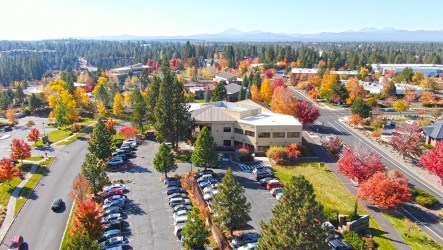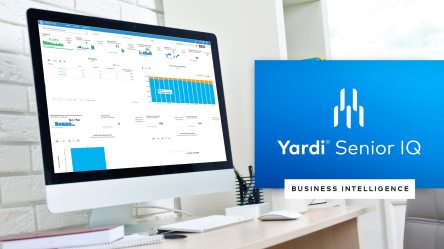The pandemic has brought change to senior living like nothing else before it. But through it all, the industry’s commitment to care has never wavered. In fact, many caregivers have gone above and beyond to keep their residents healthy and happy. In honor of these heroes, NCAL has announced “Caring Is EssentiAL” as the theme for this year’s National Assisted Living Week, set for September 13 -19. Established in 1995, National Assisted Living Week provides an opportunity for residents, loved ones, staff and the broader community to recognize the role of assisted living in helping seniors and those with intellectual disabilities. By encouraging senior living providers nationwide to host special events and activities all week long, NCAL plans to celebrate residents and caregivers together as well as educate the public about long-term care. The annual observance will have to adapt to COVID-19 restrictions this year, but despite the hurdles, the staff of senior living deserve to be recognized for their incredible work. And although the event many not look quite the same on the surface, the spirit of celebration will still be there. Socially distant activities for National Assisted Living Week Each year, NCAL puts out a planning guide for National Assisted Living Week with event ideas to inspire providers. This time around the suggestions focus on ways to have fun even with the extra safety protocols in place. Here’s a quick rundown of what they recommend: Celebrations: Try an end-of-summer ice cream delivery, schedule a family car parade and get creative with a dress-up day. Music: Host a hallway singalong, invite musicians among the community to share their gifts or stream a recorded concert. Exploration: Encourage virtual museum visits, share live webcams of zoo animals and “tour” favorite destinations through photos. Connections: Organize...
Port Management
Creating efficiencies
Editor’s note: The following interview was originally published in Pacific Ports Magazine’s August edition. It is reprinted here with permission. With over 30 years of property management and software implementation experience, Jay Rainaldi is the professional services director for government business at Yardi. and oversees the implementation, support and client acquisition in the government space. He has served on many boards and committees in the residential, military, single-family and government arenas during his career and has been a speaker and moderator at numerous industry conferences and events. Over the past decade — not to mention the past few pandemic challenged months — efficient port management has increasingly become an art in and of itself. Whether it be for management of property, facilities or construction projects, tenant services, accounting and payment processing, budgeting and forecasting or even to gain energy efficiencies, the many tasks related to port management have multiplied as the maritime world moves toward digitization, industry growth, environmental sustainability and increasing government regulations. The APP recently discussed the topic of port management with Jay Rainaldi, director of government solutions at Yardi, to gain insights into the many factors affecting efficient operations and how solutions, such as the Yardi Ports Suite, can provide much needed assistance. Jay, first, thanks for helping the Association investigate ways to assist Port Members on best practices. Could we start by identifying the trends you’ve seen in port management over the past 10 or 20 years, including how technological advances have impacted on port staff and how has port management changed? JR: Increasing globalization, world trade and financial constraints have created changes in port management in the last several years. Ports have been forced to modify their infrastructure to allow for larger ships and containers. Additionally, ports are doing...
Better AP Options
Senior Living Webinar 9/17
Senior living providers have a lot to manage in their communities, including engaging residents, dispensing medical care, interacting with families and meeting compliance obligations. Also, like other businesses, they process a constant stream of invoices for material and service purchases. Executing all the various accounts payable tasks manually is time-consuming. Could this burdensome aspect of senior living management be easier, faster and less prone to error? Yes, says Carmin Tomassi, vice president/controller for Silverado, and in a free Sept. 17 webinar he’ll share tips for better AP execution from the Irvine, Calif.-based provider of memory care assisted living and hospice services. Hosted by Senior Living Foresight and moderated by its publisher, Steve Moran, the 35-minute session will also feature Kim Hensley, manager of procure to pay for Yardi. As a Changemakers participant and Yardi client success story subject, Silverado has already offered insight into the cost, time, accuracy and scalability advantages of automated AP. At one point, for example, Tomassi’s staff wrestled with stacks of invoices in various stages of action, endured lengthy approval and reconciliation processes, and juggled no fewer than 12 different systems. Yardi PayScan scans Silverado’s invoices into electronic transactions and automates approval workflows through vendor payment in a single connected system. The solution helped Silverado cut costs with paperless processing, and it enforces consistent standards, minimizes errors and ensures timely vendor payments. Today, Tomassi says, Silverado has “a level of information that we didn’t have before. Now we can act on that data and do something about it. [PayScan] helped our accounting department improve their processes, like really getting people to pay attention to how they’re coding invoices.” Ready to banish your biggest accounts payable headaches, just like Silverado and many others did? Register for the Sept. 17 webinar. It...
ARPA-E Update
Energy Research
Earlier this year, The Balance Sheet summarized some energy technology projects sponsored by the Advanced Research Projects Agency-Energy (ARPA-E), which carries out R&D for the U.S. Department of Energy. Here are a few more active projects. Warm and cool on demand Syracuse University seeks to improve comfort for office building occupants with a near-range micro-environmental control system. The system would store the cooling produced by the compression system at night and release it as a cool breeze of air to make occupants more comfortable during the day. And when heating is needed, the system would draw heat from its phase-change material and deliver warm air. Syracuse claims that the control system, combined with an expanded set-point range, could save more than 15% of the energy used for heating and cooling while maintaining occupant comfort. “If successful, [the control system] could increase energy efficiency, reduce emissions produced by powering traditional HVAC systems, and enable more sustainable heating and cooling architectures for energy-efficient building design.” Building breath test Specialized sensors tip off a building’s HVAC system that carbon dioxide-exhaling people are around and need ventilation. A Purdue University team is working on small-scale sensing systems that would use mass and electrochemical sensors to detect the presence of CO2. The Purdue team believes that combining two unique sensing technologies into a single package for monitoring CO2 levels could reduce building energy use by nearly 30% without sacrificing occupant comfort. Chopping home energy costs Meanwhile, researchers at Texas A&M University are looking at new detection solutions for residences, specifically enhanced pyroelectric infrared sensors that track occupancy and activity. Whereas such detection sensors traditionally can only notice people in motion, Texas A&M’s proposed system would identify non-moving heat sources. Quantitative information on movement would come from an “optical chopper”...
YASC Global
Strengthens the Client Connection
The Yardi Advanced Solutions Conference began in 1999 with about 200 guests in attendance. YASC eventually encompassed six events on four continents dedicated to giving real estate professionals in-depth training in Yardi property and investment management software. There were always plenty of networking opportunities and fun as well. COVID-19 diminished in-person meetings this year but not the YASC mission. Yardi kept the tradition going in May, hosting a digital version in lieu of gathering in Washington, D.C. More than 16,000 clients around the world completed 107,000 on-demand classes and viewed 50,000 hours of content at YASC Digital. Yardi will build on YASC Digital by combining the year’s five remaining conferences into YASC Global, a presentation of more than 280 on-demand classes Oct. 20-22. Like YASC Digital, YASC Global is free to all clients and features customized, self-paced learning and market-based registration tracks. There’s also live chat support from product specialists, in-depth spotlight sessions, real-time chat with fellow attendees, prizes and giveaways, and social media interaction. Attendance at YASC Global is expected to exceed that of YASC Digital. “We’re gratified that our clients gained so much from YASC Digital. That outcome inspired us to repeat the experience and enhance it with expanded class offerings, panel sessions and exclusive special events,” said Kevin Yardi, the company’s vice president of global solutions. “We look forward to joining industry leaders around the globe in a memorable event.” Learn about the value in store for Yardi clients at YASC...
Silverado Success
Improved Clinical Outcomes
Implementing a new EHR system is not a job for one person alone. Especially when you include a medication management solution, complete with pharmacy interfaces. You need a well-coordinated team with the right partners to make sure the rollout is a success. Case in point: Silverado of Irvine, California. The organization specializes in senior care with an emphasis on memory care assisted living, as well as hospice. Silverado’s philosophy of care pursues “a symbiosis of top-notch clinical care and compassion that recognizes each client, resident or patient’s uniqueness.” After years of growth on ALMSA eMAR, Silverado was interested in upgrading to further support their nurses. Since they were already a Yardi client, leadership sought a solution that would not only integrate with Yardi Voyager but also provide advanced clinical capabilities for residents across the continuum of care. The Solution: Yardi EHR and Yardi eMAR Yardi EHR is an electronic health record solution designed for assisted living, independent living, memory care and skilled nursing. The single-vendor solution combines clinical intake processing, resident assessments, care planning, wound treatment, behavior management and more in a browser-based platform optimized for mobile devices. Yardi eMAR simplifies medication administration through an online solution that interfaces seamlessly with pharmacy partners. Advanced drug database and clinical support functionality also helps expedite order entry and promote compliance. The Story: Collaborating for Improved Clinical Outcomes Silverado leadership understood the importance of allocating resources to ensure successful continuity of care, resident safety and compliance. They knew from the start to accomplish these goals would take a collaborative effort. Based on their experience working together, Yardi was selected as the right partner, and a pilot began in early 2018. “Our pilot went extremely well,” said Beth McCurdy, senior director of clinical informatics at Silverado. Nursing staff...
OHCA 2020
Celebrating Health Care Heroes
Over the past half year, senior living teams have been working tirelessly to keep residents safe, engaged and happy. Although the pandemic has created many new challenges for the industry, it’s been incredible to see how many people have stepped up to help. In honor of these courageous, masked caregivers, the Oregon Health Care Association are “Celebrating Health Care Heroes” as the theme for their biggest event of the year: the OHCA Annual Convention and Trade Show. Of course, the event, always well attended, is making changes to protect the health of members and their residents. It’s now a live virtual experience, scheduled for September 15 and 16 with pre- and post-event activities as well as on-demand education available afterwards. The event may be different than what you’re used to, but there’s a lot to be excited about: Live-streamed keynotes and sessions, including tracks on leadership, clinical, nursing facilities, quality improvement, COVID-19 and more Networking opportunities to connect with other attendees and presenters through interactive live discussions and Q&A chats The OHCA Awards ceremony where deserving staff are recognized for their dedication to the care profession Yardi is proud to sponsor the awards ceremony this year. Now more than ever, it’s important to honor those who go above and beyond for others. As this year’s theme makes clear, these hard-working individuals are true heroes. Visit Yardi on the virtual trade show floor During the event, you’ll also be able to stop by our booth to see what’s new with the Yardi Senior Living Suite. We’ll have plenty of resources to download, products to showcase, plus a giveaway for a lucky few! And if you want to talk with us face to face, there’s even a video chat option. We’re grateful to each and every...
Compass Commercial
CRE firm is new Yardi client
Bend, Oregon is well-known for its gorgeous mountains, forests and rivers, well-balanced and high quality of life, and prospering remote work culture (even prior to COVID-19). So, it’s no surprise that despite the pandemic, real estate is continuing to thrive in Central Oregon. Nearby cities Redmond (home to the Bend/Redmond regional airport), Sisters (a charming tourist destination) and Prineville (hometown of Les Schwab tires and now the location of a major Facebook data center) are seeing a boost as well. The team at Compass Commercial Real Estate Services, a new Yardi CRE client, knows that firsthand. They have been providing asset management, construction, brokerage and leasing services since 1996. Currently, their management portfolio includes 700,000 square feet of office assets, 500,000 square feet of retail, and 500,000 square feet of industrial. “We originally started out managing single individual assets, and as Bend grew, we began moving into the next generation of institutional buyers and local owners with portfolios,” said Jackie Niebling, Vice President of Asset and Property Management and a principal broker for Compass Commercial. “Bend has become a hotbed for individuals seeking work-life harmony. We’re seeing a great deal of activity from outside investors wanting to invest in Bend so that they can relocate here and enjoy our lifestyle,” Niebling summarized. A privately held company, Compass Commercial is not only the largest CRE provider in the region but also a leading authority on regional real estate activity. They even publish a quarterly guide to local rent and transaction activity aptly titled “Compass Points,” which offers a comprehensive snapshot of CRE trends. The most recent edition focused in on the impacts of the pandemic on Central Oregon real estate. And apart from smaller office leases, things appear to be holding up well. Retail and...
End of Urbanization?
New attention for suburbs
For years, 24-hour and 18-hour cities, and the live-work-play concept, have been mantras in commercial real estate. Suddenly, however, cities are facing a pandemic-driven exodus. Is this a temporary blip or the start of a long-term trend? COVID-19’s impact has been particularly deep in major metropolitan areas such as New York City, Los Angeles, Chicago and San Francisco office space, which have also seen sharp drops in apartment occupancy rates and rents as the city centers are largely shut down and residents shelter elsewhere. In Manhattan, for example, office buildings that were closed for months remain mostly empty upon re-opening, as employers avoid putting workers at risk and people avoid public spaces. Midtown streets that are typically teeming with tourists are nearly empty as Broadway and other entertainment venues remain shut. New York City’s story is being played out in city centers across the country. Not only do urban areas temporarily lack the jobs and cultural institutions that drew people there, but the crowds and closeness are suddenly an element to be feared rather than fascinate. Few if any saw this coming, as growth has coalesced in cities in recent years. The United Nations has forecast that 75 percent of the global population would live in cities by 2050, doubling their size, and the U.S. seemed to be headed in that direction. A recent study of the largest 30 U.S. metros by the George Washington University School of Business and Smart Growth America in conjunction with Yardi Matrix found that walkable neighborhoods encompassing office, housing, retail and entertainment grew faster and produced higher absorption and rent growth over the last decade than counterparts without that combination. During that time, 70 percent of the jobs created were in the top 50 U.S. metros. Corporations have been...
Dementia Care Reimagined...
Ikea + H.M. Queen Silvia
Two unlikely forces are improving dementia care in Sweden. A member of the royal family is collaborating with a ready-to-assemble home supply store. Together, they’ve reimagined senior housing development in a way that is affordable, sustainable and chic. The collaboration couldn’t have come at a better time. By 2040, nearly one in four Swedes will be 65 years or older. While long life expectancy is a good problem to have, the government desperately seeks affordable ways to fund care for its aging population. Queen Silvia has taken a personal interest in the nation’s senior care. After losing her mother to Alzheimer’s, she became more involved in dementia care initiatives. BoKlok, an affordable and sustainable housing partnership between Ikea and Skanska, captured her attention. The three powers began a multi-decade endeavor to develop an affordable approach to housing the nation’s elderly while keeping quality and sustainability at the forefront of their efforts. SilviaBo: affordable, sustainable housing Together, BoKlok and Queen Silvia created SilviaBo, senior housing developments that rose to the demands of affordability, quality and comfort. They are designed to allow seniors to age in place rather than nursing homes. “To take care of elderly people, that cost is exploding,” BoKlok CEO Jonas Spangenberg told CNN Business. “It’s much cheaper for society and the public to give them service back home.” To date, SilviaBo includes 11,000 prefab homes with communities in Sweden, Norway and Finland. Their success has relied on the Ikea model for mass production. To keep costs low, the homes are produced in high volumes in warehouses, succinctly packed and then shipped to the site. Ikea and Skanska also took responsibility for the supply chain from start to finish: land acquisition, production, assembly, marketing and leasing all take place under the BoKlok umbrella....
Yardi + AIM
Live webcast Sept. 17
Are you missing live events? While we can’t bring back the hum of the tradeshow floor just yet, we’re excited to team up with AIM to host a live webinar event that we hope will rival some of your favorite speaking sessions from conferences past. Keep reading to see how we’re bringing industry leaders from Bozzuto, KETTLER and The Management Group together on one virtual stage … and why you want to reserve your seat asap. The New Apartment Marketing Playbook: Consumer Behavior Has Shifted, Have You? Thursday, Sept. 17, 11 a.m. PDT Even as the COVID-19 pandemic continues, renters are still on the move. With social distancing measures in place, renters expect to interact with properties in new ways. This increasing demand for virtual and contactless engagement is nothing new. But now that we’ve adapted to a new norm and the virtual conveniences that come with it, there’s no going back. Considering this shift in consumer behavior, here are some questions your property management teams may be facing: Is it possible to create an online experience as powerful as a visit to your properties? How can you offer game-changing online and self-service tools that don’t compromise your security standards? What should your leasing agents be doing to pivot and provide real value in an increasingly virtual world? “Don’t lose customers to your competitors while you’re waiting for things to ‘get back to normal.’ Normal as we knew it is changing. Taking this opportunity to make smart updates to your leasing process will have a lasting positive impact on your business in the months and years ahead,” said Esther Bonardi, session moderator and vice president of marketing at Yardi. During this live online event, you will learn how to: Convert more renters by creating authentic experiences onlineLease more units by offering a range of tour types to fit every needImprove the prospect experience while prioritizing the safety of your team and propertiesEvolve leasing positions to meet the demands of the new customer experience Speakers include: Jamin Harkness, Executive Vice President, The Management GroupKelley Shannon, Senior Vice President, Marketing & Customer Engagement, BozzutoDaryl Smith, Senior Vice President & Chief Marketing Officer, KETTLER Free ebook Webinar registrants will receive a free copy of The New Apartment Tour with their confirmation email. This exclusive ebook details three ways you can modernize different tour types at your properties to convert more renters, both online and in person. Save your seat today to get your...
Improving Energy Efficiency
For Class B and C
Class A commercial buildings get all the fanfare. They have the nicest amenities, the best views and, of course, the highest rent. But let’s not overlook the value that class B and C spaces bring to communities and business owners. Often located in suburban areas or lacking glamour that high rises provide, these buildings still possess many advantages and simply don’t get the same type of recognition. A recent ENERGY STAR® report stated that 94% of all U.S. commercial buildings were properties under 50,000 square feet. Because class B and C buildings significantly outnumber class A, they can lead the way in contributing to a cleaner environment, improved leasing practices and cost savings techniques. At the recent 2020 Virtual BOMA Conference, Marta Schantz, senior vice president of Urban Land Institute (ULI), explained three major challenges for class B and C owners in regard to energy efficiency: Information constraints – Stakeholders are so consumed with day to day operations that energy efficiency gets put on the backburner. Lean on your property manager for data and best practices and educate yourself about building benchmarks to understand what’s working or not. Resource constraints – These buildings don’t have the budget or staff size of class As, so they often lack someone specifically assigned to energy projects, or a third party hired to oversee this aspect of the portfolio. Funding constraints – B and C class buildings typically don’t have capital planning funds to invest in larger retrofits with up-front costs. Owners also may not be able to take on long-term debt. How can a building owner overcome some of these challenges? Primarily, there are financing options available so that B and C owners can reach long term savings goals: cost recovery in terms of lease forms, utility on-bill financing, commercial property assessed clean energy financing (C-PACE), among others. As Schantz explained, an HVAC retrofit alone may not provide the necessary ROI, but bundled with LED installation or sensor installation, it can provide long-term savings with a relatively short-term payback process. As explained in a 2020 BOMA report, class B and C properties could save 15% on energy costs with basic low- to no-cost initiatives, or even up to 35% with the larger investments detailed above. BOMA’s research has found that sustainability initiatives can reduce operating expenses for class B and C buildings between $0.26 and $0.61 per square foot and increase the net operating income for these properties between 2.4% and 5.6% per year. What are some of the simplest energy solutions to implement? According to Joey Cathcart, associate at the Rocky Mountain Institute, here are some of the best low-cost, quick payback measures for energy savings across property type: LED lighting: LEDs use significantly less energy and last much longer than incandescent lighting. Controls/Sensors: Install LED’s in high-use areas and controls or sensors in low-use areas like closets and restrooms. Programmable thermostats: Simply program your temperature setting in times of low or no occupancy. Energy audits: Establish a baseline and identify where improvements can be made. Local authorities often provide grants for these projects. Window filming or shading: Reduce demands on HVAC and reduce solar radiation with tinting or shading. Lease provisions and green leases help increase investor, owner and tenant interest. “They help to overcome split incentives, improve transparency and indicate a commitment to sustainability,” Cathcart said. He detailed three low cost components to drive the highest lease impact: Integrate new building expectations by implementing low or no cost strategies into standard operating procedures. Integrate language into leasing that includes periodic energy audits. Tenants see this as a commitment to sustainability. Document operating best practices to optimize performance in common areas and tenant spaces. “The best time to integrate provisions is either during tenant renewal or at the beginning of a new tenant lease,” Cathcart explained. Eugenia Gregorio, founder and principal at Gregorio Sustainability, presented a case study of The Tower Companies...
Back to the Office
Legal Considerations
One of the most significant factors hindering a smooth return to work has been the legal uncertainties surrounding COVID-19. The main concern is the lack of uniformity in the laws between jurisdictions, and the tightening and loosening of restrictions as cases rise or fall. Therefore, employees, tenants and landlords all need to understand what can and cannot be enforced. Contract clauses, deferrals and concession negotiations have been ongoing since March, and the ramifications of these changes will carry on for months to come. Compliance for reopening If a manager cannot ensure the safety and wellbeing of workers, then an office simply cannot reopen. On a recent Realcomm webinar, Evandro Gigante, partner at Proskauer law firm, explained that compliance for reopening varies by jurisdiction, but New York, where their main office is located, has a thorough set of rules laid out for businesses to reopen. “There is a very robust set of guidelines that include, among other things, the development of a comprehensive health and safety plan which requires a close look at screening, testing, contact tracing, signage and social distancing procedures to be put into action,” he said. The guidelines require a written document detailing expectations for landlords and employers. Administering questionnaires regarding self-health is going to be a key, and there will be many questions about the legality or requirements involved with temperature taking. “Under Equal Employment Opportunity Commission (EEOC) guidelines, you can diagnostically test your employees,” Gigante explained. “But the EEOC has not sanctioned antibody testing for the purpose of making employment decisions.” You can legally collect medical information on individuals, according to the EEOC, including their temperature or their symptoms, as long as you maintain it confidentially and separately from personal files. But here is where different jurisdictions and different guidelines...
Working From Home
Productivity Pluses
Gallup reported that the percentage of employed adults working from home because of the coronavirus went from 31% in mid-March to 49% a few days later, peaking at 62% in mid-April. That’s a lot of people suddenly forced to accept drastic new circumstances. How is working from home, which the COVID-19 pandemic made a necessity in many sectors, affecting business productivity? Problems made worse? Some workers weren’t fully enthusiastic about the work-from-home concept even before the pandemic. About 29% of respondents to a poll of full-time U.S. employees taken in 2019 by outsourcing marketplace platform Airtasker said they experienced difficulty maintaining a healthy work-life balance; 23% of office workers reported the same problem. Remote workers also reported higher levels of stress, anxiety and procrastination. (Telecommuting respondents did appreciate eliminating their commutes and reported putting in longer workdays than their office-based counterparts.) The initial stages of the pandemic amplified those issues. “The scale and scope of what we’re seeing, with organizations of 5,000 or 10,000 employees asking people to work from home very quickly, is unprecedented. So, no, organizations are not set up for this,” Tsedal Neeley, a professor at Harvard Business School, said in March, citing concerns about ensuring employee access to hardware, software and other resources. Neeley also addressed the social aspects of work: “People lose the unplanned watercooler or cappuccino conversations with colleagues in remote work. These are actually big and important parts of the workday that have a direct impact on performance.” She wasn’t the only one bemoaning the loss of in-person collaboration. “I fear this collapse in office face time will lead to a slump in innovation,” says Nicholas Bloom, a senior fellow at the Stanford Institute for Economic Policy and Research. “The new ideas we are losing today could show...
Make Ready Solutions
Increase NOI and Revenue
When was the last time that you reviewed your unit make ready process? During difficult financial times, it is essential for multifamily managers and owners to cut overhead costs and improve efficiencies in every area of business. You could notably improve portfolio valuation by optimizing how you turn a unit. Yardi caught up with Jennifer Price, director of systems at Walton Communities, to dissect and interpret the latest in multifamily make ready data. Our experience reveals how web-based technologies reduce unit turnover costs and promote efficiency. Economic downturn prompts research into cost-saving measures For property managers and owners, efficiency matters more than ever. The U.S. economy is currently in recession, and multifamily market data for summer 2020 reveals negative rents in the second quarter. This is the first prolong quarter of negative rates since the aftermath of the global financial crisis. Rents drops aren’t expected to rebound until 2021. In multifamily housing, spring is normally a time for growth. Most markets would experience rent growth of about 2% in the second quarter alone. At the end of the first half of 2020, however, rents fell 1.8% year-over-year for luxury lifestyle units. Working-class renter-by-necessity units were only up by 1.4%. Additionally, occupancy rates dropped 30 basis points nationally to 94.4% through May. Analysts forecasts that occupancy rates will continue to decline. A typical multifamily portfolio consisting of 10,000 units will turn 30%-50% of their units each year. Unit turns require a sense of urgency: getting the unit back on the market means restoring cash flow and cutting vacant unit losses. When the turn process is inefficient, however, the portfolio may experience between $2 million to $3 million of NOI losses, or about $40 to $60 million of potentially unrealized asset value, states a recent report...
Sublease Space to Spare?
Commercial Vacancy High in Major Metros
Commercial real estate has encountered a space problem: there is too much of it. Unused, unwanted square footage is having a ripple effect throughout the industry, stalling new deals and prompting tenants to get creative with their leases. Which markets have the most excess space? Tech markets such as San Francisco and Boston are among the cities with the most space to spare. The report suggests that tech companies often lease more space than they need. If they are hit with a sudden need to expand, the resources are readily available. Conversely, they are apt to offload unneeded space during economic downturns such as this one. Markets with a broader range of employment sectors recorded more modest increases in available space. Dallas-Fort Worth, Manhattan, and Washington, D.C. are among the top markets with a moderate increase in excess space scattered across its large providers of health care, tech and energy services. “We believe that the second quarter was the low point for the market with office leasing activity down by more than 40 percent from a year earlier – and that we’ll begin to see a gradual recovery,” says Ian Anderson, CBRE’s Americas Head of Office Research in an interview with World Property Journal. Huston was the only market with negative space to lease between March and June 2020. The city recorded a -2% change for a total of 5.2 million sq. ft. How is the excess space impacting the commercial market? Though the national vacancy rate increased 10 basis points to 13.2%, listing rates remain comparable to figures recorded at this point last year. Average full-service equivalent listing rates only fell by 0.7% to $38.15 per square foot in May. Analysts suggest that the demand for new office space has declined to such a point that traditional price reductions would not produce the desired effect. Additionally, multi-year office leases make substantial price decreases unfeasible. It also seems that many office owners are still optimistic for a V-shaped recovery, counting on pre-COVID-19 levels by Q4. While listing rates seem stable, the excess office space has had a notable effect on future demand. Per the Yardi Matrix Office National Report, the second quarter recorded only $4.4 billion in transactions compared to $12.7 billion at this point last year. Buildings near completion are still slated for delivery. New supply, however, is being added at a pace slower than seen at this point in 2019. The total amount of planned office space decreased by 8.5%. Due to the current downturn, analysts expect deliveries to continue at a slower pace than last year. Get the complete Yardi Matrix Office National Report Subletting office space provides some relief to lessors The recession, high vacancies rates and low demand have left tens of millions of square feet on the negotiation tables. To add to the excess, the average company requires about 20% less space now than it did pre-COVID 19. The market has plenty of space to spare, and tenants are seeking creative ways to make the most of unused square footage. Per a recent report by global property consultant CBRE, the 10 largest U.S. office markets experienced a 12% increase in space offered for sublease. Since March, the major markets offered 6.1 million additional square feet of space to bring the current total to 59 million. Lessors seek to sublet to recuperate costs on unused space. Per Tenant CS, which offers conflict-free tenant representation services, tenants can expect to recover less than 50% of their rent obligation. During the current economic downturn, that cushion may be the difference between making rent or not. Nearly half of commercial retails rents were not paid in April and May, for example. Figures are better for office tenants. Currently, REIT-owned office buildings report that they are collecting about 90% of rents from tenants. The concern, however, is that employers will embrace remote work for good. Some will make...
Senior IQ Update
New Look, New Tools
Yardi Senior IQ has been out for a few months now, and it’s already seen a huge amount of interest from the industry. As clients have gotten into the swing of things, their feedback is helping make the business intelligence solution even more useful for senior living. The latest release, Senior IQ 1.6, is now live. To make the upgrade process easier for our clients, Yardi is switching away from manual installs for new Senior IQ plugins. Yardi can now take care of things automatically, so you get the latest features as soon as they’re ready. Check out these highlights of what’s new in Senior IQ: Home page redesign The home page has a new look to ensure the first data you see after signing in is clear, relevant and actionable. The portfolio statistics at the top have been replaced with three customizable tiles. You can sort KPIs for all your communities by different attributes like property owner, care level or region, and your occupancy percentage and census are also available at a glance. Below the tiles, the community section now sports a tabbed format. You can easily switch between the table grid and map, depending on what you’re most interested in seeing. We’ve added display settings as well that let you customize the density and layout of your data. To top it off, you can now export the community grid to an Excel spreadsheet. Tool tips With the abundance of KPIs, tiles and widgets available in Senior IQ, it’s important to know what each does when you’re reviewing or building out your dashboards. That’s where the new tool tips come in. Hover your mouse over the familiar blue information icon on a widget or measure to see a quick explanation of what it’s...
News Worth Sharing
Senior Living Stays Positive
The recent surge in coronavirus cases is nothing but troubling, but examples of positivity continue to spring from many senior living communities. In between the extra safety steps and social distancing measures, they’ve shown there’s a lot to be happy about and thankful for. Read on for our next roundup of good news from Yardi senior living clients. We even have some closure on a story from last time. Enjoy! Life imitating art imitating life Back in March, the Getty Museum asked people online to recreate pieces of famous art using everyday objects and attire. Since then, thousands around the globe have taken part, including residents of American House Senior Living communities. With group activities temporarily stopped for safety reasons, the creative challenge gave residents another way to liven up their days — in style. “This was a great program for social distancing, as each resident could participate without ever leaving their rooms,” said Darcy Santos, corporate director of life enrichment for American House. “Some of the life enrichment directors provided the residents with books or links to famous works of art online, but each resident decided on how they wanted to create their masterpiece.” You can check out all the incredible photos on McKnight’s Senior Living. Safe, self-contained meeting spots Tablets and video calls are keeping many residents connected with family members, but nothing can fully replace the in-person visit. To help bring loved ones back together, PARC Retirement Living in Vancouver came up with a clever solution: pre-fabricated pods with separate entrances and a glass barrier to facilitate safe face-to-face conversations. “At first people weren’t sure — when the pods arrived there was no signage. It was just this bright orange trailer, and they said ‘I’m not going to use that. It’s...
Senior Living AP
Cascadia Saves Days of Work
Growth may be a good problem to have, but you still need a way scale efficiently and effectively. Especially when it comes to accounts payable. As the number of communities in your portfolio grows, so too does the number of vendors to manage and invoices to process. Based out of the Pacific Northwest, Cascadia Senior Living and Development creates and operates innovative independent, assisted living and memory care communities. They started in 2014 with one community, and their commitment to providing excellent care has since helped them expand to 13 communities across Washington and Oregon. For Cascadia’s AP team, things eventually hit a point where their original workflows weren’t sufficing. “Basically, some of the processes that we had in place when we had one community didn’t scale for when we had 13,” said Michael Shefter, CFO of Cascadia. “We had an employee here, our accounts payable manager, who would stuff envelopes for all the checks that we had to cut for our communities.” Cascadia receives roughly 1500 invoices a month, so the time it took to process them all was significant. Already a Yardi client, Cascadia turned to Yardi Bill Pay for the solution. Keeping check cutting in check Part of the Yardi Senior Living Suite, Bill Pay outsources the process of paying vendors to Yardi. The Bill Pay team takes a client’s invoices, routes them through the approval workflow and pays the vendor by ACH, credit card or check. In Cascadia’s case, they decided to have Yardi physically print and mail the checks. The process for getting started with Bill Pay was painless, since it integrates with Yardi Voyager Senior Housing and any already established workflows. Cascadia began with one test community in early spring. “We rolled Bill Pay out with a check...
Tulsa Real Estate Fund
Investment Opportunities for All
Did you know that about 90% of millionaires built their wealth through real estate? Between 1932-2012, however, the average American faced multiple barriers to entry for real estate investment. New laws limited participation in investments, placing a hurdle between small-time investors and wealth. Crowdfunding, legalized in 2012, is a relatively new opportunity for people with limited income to invest in large projects. It permits accredited and unaccredited investors to build wealth through real estate and other investments. The Tulsa Real Estate Fund (TREF) was the first African American owned and managed regulation A+, two-tier real estate investing crowdfund in American history. Its initial purpose was to help low-income families participate in real estate investments that build wealth and combat gentrification. Since then, it has expanded its services to accredited and unaccredited investors. Barriers to entry for low-income families and minorities TREF is a nod to the nation’s past when communities invested together to achieve success against all odds. In the early 1900s for example, the predominately black community of Tulsa, Oklahoma used small group investments to development the town. Conventional lenders would not serve black communities, yet new industries, businesses and families flourished thanks to collective investments. The Greenwood District of Tulsa became so successful that it was called Black Wall Street. Group investments helped the town overcome discriminatory lending practices, but the community would soon face a larger hurdle. In 1921, Tulsa experienced a wave of domestic terrorism later known as the Tulsa Race Riots and the Tulsa Massacre. Though the catalyst is still under dispute, the event resulted in the deaths of as many as 300 African Americans, 800 injuries, and 35 city blocks bombed and set ablaze by white mobs and the National Guard. The events destroyed Black Wall Street and left many families homeless and without a source of income. Tulsa was not the first or the last successful black town to be destroyed by a combination of economic sabotage and domestic terrorism. Following the Great Depression, low-income and minority investors would face new challenges. The Security and Exchange Commission took shape. It is credited for protecting investors from schemes that were rampant during economic recovery. Simultaneously, it hindered how lower-income families could participate in the recovery: investors were required to receive accreditation, the guidelines for which demanded a net worth in excess of $1,000,000. It would be 80 years before an organization like TREF brought large-scale investments back into the hands of the average American. Forming TREF From the end of the Great Depression to 2012, low-income families and minorities were limited in investment opportunities and success due to a combination of domestic terrorism, economic interference and new laws. In 2012, the Obama administration signed the Jumpstart Our Business Startups (JOBS) Act into law. The JOBS Act creates opportunities for people and organizations to participate in investments and publicly raise funds from accredited and unaccredited investors. This new era of crowdfunding lay the foundation for The Tulsa Real Estate Fund, where investments begin as low as $500 at $50 per share. The organization was named to honor the entrepreneurial spirit of Tulsa’s Black Wall Street. It is aimed to highlight the correlation between small investments, real estate and the will to succeed against the odds. TREF founder Ernestine Johnson explained, “The goal of the Tulsa Real Estate Fund, which I cofounded with my husband, is to spread a message of financial empowerment and financial literacy in underserved and working-class communities.” The women propelling TREF Around 2017, Johnson learned that the median net worth for black women in her age range was $500. “This did not sit right with me,” recalled the television actress. “I was standing on $1,000 shoes. I said to myself, ‘I have to use my art and my voice to financially empower low income, underserved and urban communities,’” said Johnson. Johnson recruited Johnetta Paye to form TREF. Paye is the owner...




















